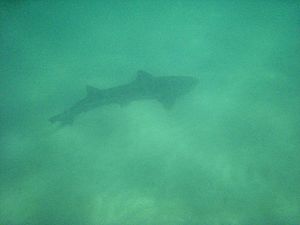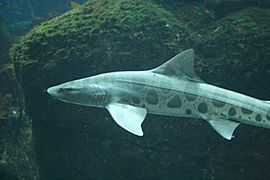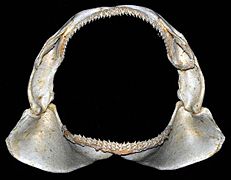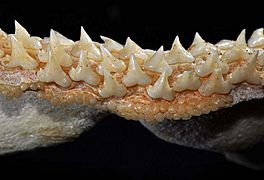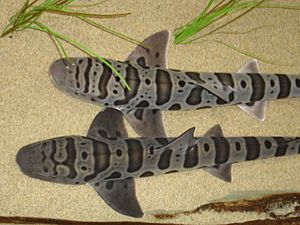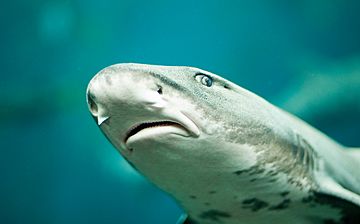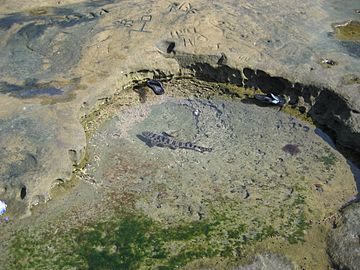Leopard shark facts for kids
Quick facts for kids Leopard shark |
|
|---|---|
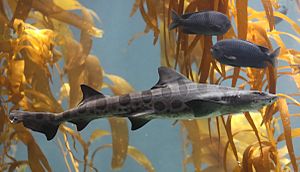 |
|
| A leopard shark and two blacksmith damselfish in the Birch Aquarium | |
| Conservation status | |
| Scientific classification | |
| Genus: |
Triakis
|
| Species: |
semifasciata
|
 |
|
| Range of the leopard shark | |
| Synonyms | |
|
Mustelus felis Ayres, 1854 |
|
The leopard shark (Triakis semifasciata) is a type of houndshark. It belongs to the family called Triakidae. You can find these sharks along the Pacific coast of North America. Their range stretches from Oregon in the U.S. all the way down to Mazatlán in Mexico.
These sharks usually grow to be about 1.2 to 1.5 meters (4 to 5 feet) long. They have a slim body and are easy to spot because of their cool black markings. They have saddle-like shapes and large spots all over their back. This unique pattern is how they got their name, the leopard shark!
You can often see large groups of leopard sharks. They swim in bays and estuaries, especially over sandy or muddy areas. They also like rocky spots near kelp beds and reefs. These sharks prefer to stay close to the coast, usually in water less than 4 meters (13 feet) deep.
Leopard sharks are active predators. Groups of them often follow the tide onto muddy flats to find food. They mainly eat clams, spoon worms, crabs, shrimp, small bony fish, and fish eggs. Most leopard sharks tend to stay in one area. They don't travel far, which has led to different groups of sharks in different regions.
This species gives birth to live young. The babies hatch inside the mother and are fed by a yolk sac. From March to June, a female can give birth to up to 37 pups. This happens after she has been pregnant for 10 to 12 months. Leopard sharks grow slowly and take many years to become adults.
Leopard sharks are harmless to people. They are caught by both commercial and recreational fisheries for food. Some are also caught for aquariums. In California, fishing rules helped their numbers recover after a decline in the 1980s. The International Union for the Conservation of Nature says the leopard shark is of "Least Concern". However, they note that local groups of sharks can easily be overfished. This is because they grow slowly and don't move around much.
Contents
Shark Family Tree
The first scientific name given to the leopard shark was Triakis californica in 1851. However, this name wasn't properly described. In 1854, another scientist described the species as Mustelus felis. Then, in 1855, French biologist Charles Frédéric Girard published a description, naming it Triakis semifasciata.
Even though Mustelus felis was named first, an error in recording dates led to Triakis semifasciata becoming the widely used name. Because of this long-standing use, Triakis semifasciata is now the official scientific name. The word semifasciata comes from Latin words meaning "half" and "banded." This describes the shark's unique pattern of markings. In older books, this shark was sometimes called a "tiger shark" or "catshark".
{{cladogram|title=|align=left|caption=How houndsharks are related, based on their genes. |clades=
|
|||||||||||||||||||||||||||||||
The group of sharks called Triakis has two smaller groups. The leopard shark is in one of these groups, along with the banded houndshark. A study in 2006 looked at the genes of these sharks. It showed that the leopard shark might be one of the earliest members of its family.
Where Leopard Sharks Live
Leopard sharks live in the northeastern Pacific Ocean. You can find them in the cool waters off Coos Bay, Oregon, down to the warmer waters of Mazatlán, Mexico. This includes the Gulf of California.
They love muddy or sandy areas inside enclosed bays and estuaries. You might also see them near kelp beds and rocky reefs. Sometimes, they gather near warm water coming from power plants. Leopard sharks usually swim close to the bottom. They are most common in shallow water, about 4 meters (13 feet) deep. But they can be found as deep as 91 meters (299 feet).
Many leopard sharks, especially in the north, leave their coastal homes in winter. They return in early spring. A study in Tomales Bay, California, found they leave when the water gets colder than 10–12 °C (50–54 °F). One tagged shark swam about 140 kilometers (87 miles) south!
Most leopard sharks stay in one local area for much of their lives. They don't travel far. This means that sharks in different areas have become genetically different. Scientists have found seven distinct groups of sharks along the California coast. The group in Humboldt Bay is quite isolated. These sharks grow larger and have fewer babies than sharks from other areas.
What Leopard Sharks Look Like
The leopard shark has a fairly strong body with a short, rounded snout. It has skin flaps in front of its nostrils. Its eyes are large and oval, with a special protective third eyelid. The mouth curves strongly. There are grooves at the corners of its mouth.
Leopard sharks have many rows of teeth. There are 41 to 55 rows in the upper jaw and 34 to 45 in the lower jaw. Each tooth has a smooth, pointed center and one or two small points on each side. These teeth are arranged like a flat, "pavement" surface.
The first dorsal fin (on its back) is large. It's located about halfway between its pectoral and pelvic fins. The second dorsal fin is almost as big as the first. The anal fin (near the tail) is much smaller. The pectoral fins are wide and shaped like triangles. The lower part of the caudal fin (tail fin) is well-developed in adults.
The leopard shark's color is very special. It has clear black "saddles" and large black spots along its back. These markings are on a silvery to bronze-gray background. Adult sharks often have more spots and saddles with lighter centers than younger sharks. Their underside is plain and whitish.
On average, a leopard shark is about 1.2 to 1.5 meters (4 to 5 feet) long. Males can sometimes grow to 1.5 meters (5 feet), and females to 1.8 meters (6 feet). There's even a record of a female that was 2.1 meters (7 feet) long! The heaviest known leopard shark weighed 18.4 kilograms (40.6 pounds).
Leopard Shark Behavior and Life
Leopard sharks are active swimmers. They move with strong, wavy motions. You can often see them cruising in or just beyond the surf zone. They are more active at night than during the day. Sometimes, they even lie still on the bottom. In places like Tomales Bay, leopard sharks follow the tide onto mudflats to find food. They retreat just fast enough to avoid getting stuck when the water goes out.
From birth, leopard sharks form large groups. These groups are usually separated by age and sex. They might also mix with other types of sharks, like smoothhounds or spiny dogfish. These groups seem to move around a lot. They might appear suddenly in an area for a few hours and then disappear. In aquariums, bigger sharks have been seen showing dominance over smaller ones. They do this by lightly nipping their fins.
During summer days, many adult female sharks gather in shallow bays and estuaries. They spread out at night. These females follow the warmest water patches. This helps them raise their body temperature by up to 3 °C (5.4 °F). Scientists think they do this to help themselves and their unborn babies grow faster. The sharks in these groups change often. Individual females move between different spots several kilometers apart.
Leopard sharks have smaller and more numerous red blood cells than some related sharks. This helps them use oxygen more efficiently. This might be an adaptation for finding food in estuary environments, where oxygen levels can be low. Their eyes have very few color-sensing cells. This is probably because they live in murky water.
Small leopard sharks can be eaten by larger sharks. These include the great white shark and the broadnose sevengill shark. Once, a sevengill shark was seen ambushing a leopard shark on a mudflat. It hit with such force that the larger shark briefly beached itself! Leopard sharks can also have parasites, like certain tapeworms and copepods.
What Leopard Sharks Eat
Leopard sharks eat small animals that live on the bottom or near the shore. Their main foods are crabs, shrimp, small bony fish (like anchovies, herring, and gobies), fish eggs, clams, and the echiurid fat innkeeper worm. These sharks are opportunistic hunters. This means they will eat whatever food is available. They have also been known to eat ghost shrimp, polychaete worms, and the young of other sharks and rays. Sometimes, they accidentally swallow eelgrass and algae.
The leopard shark catches prey by quickly opening its mouth wide. This creates a suction force. At the same time, it pushes its jaws forward to grab the prey with its teeth. Like other sharks, leopard sharks regularly lose and replace their teeth. It takes about 9 to 12 days for a new tooth to move into place.
Scientists have found clam siphons in the stomachs of leopard sharks. The sharks grab these siphons before the clams can pull them back. They then use their bodies to break them off. Sometimes, the shark pulls the entire clam out of its shell! Other sharks have had whole innkeeper worms in their stomachs, with no bite marks. This suggests the sharks sucked them right out of their burrows.
In some places, leopard sharks eat only a few types of prey. For example, in Tomales Bay, they mostly eat innkeeper worms and certain crabs. In Humboldt Bay, they eat fish eggs and different kinds of crabs. What they eat depends on where they are, the time of year, and their age. Young sharks mostly eat crabs. As they get bigger, they start eating clam siphons, fish eggs, and innkeeper worms. The largest sharks eat the most fish.
Leopard Shark Life Cycle and Reproduction
Leopard sharks give birth to live young. The baby sharks grow inside the mother and are fed by a yolk sac until they are born. In northern areas, females use bays and shallow areas as nurseries for their babies. In the south, they give birth in more open waters.
Females give birth to 1 to 37 pups each year, usually between March and July. Most births happen in April or May. The number of babies increases with the size of the mother. In some bays, females drop their pups in beds of eelgrass. This provides both shelter and food for the young sharks. In other areas, females give birth in very shallow water, sometimes with their backs exposed. The pups then stay in even shallower water.
Mating happens in early summer, after the babies are born. One observation of mating in the wild happened in 2004. Nine sharks gathered close to shore in shallow water to mate.
Newborn leopard sharks are about 20 centimeters (8 inches) long. They grow relatively slowly after their first 3 to 4 years. Male sharks grow about 2.0 centimeters (0.8 inches) per year. They become adults at 7 to 13 years old, when they are about 0.7 to 1.2 meters (2.3 to 3.9 feet) long. Females grow about 2.3 centimeters (0.9 inches) per year. They become adults at 10 to 15 years old, when they are about 1.1 to 1.3 meters (3.6 to 4.3 feet) long. Sharks of the same age can be very different in size. Very large sharks grow especially slowly. One shark was only 4 centimeters (1.6 inches) longer after 12 years! Leopard sharks are estimated to live for up to 30 years.
Leopard Sharks and People
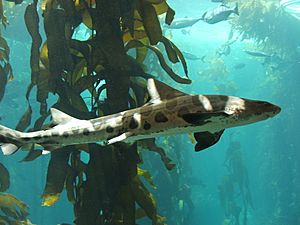
Leopard sharks are shy and usually swim away from people. They are almost no danger to humans. There is only one report from 1955 of a leopard shark bothering a diver with a nosebleed, but no one was hurt.
People catch this species for food using gillnets and longlines. Recreational anglers and spearfishers also catch them. Sometimes, they are caught by accident in bottom trawl nets. The meat is considered good to eat and is sold fresh or frozen. However, leopard sharks living near human development can have pollutants in their bodies. These include mercury, pesticides, and PCBs. Because of this, the California Department of Fish and Wildlife warns against eating them too often.
Leopard sharks are also popular in aquariums because they look nice and are hardy. This led to many newborn pups being caught for the aquarium trade in the late 1980s and early 1990s. A leopard shark can live for over 20 years in an aquarium.
Most leopard shark fishing happens off the coast of California. Commercial catches were highest in 1983. Since 1991, they have averaged about 14,060 kilograms (31,000 pounds) per year. These numbers might be low because some leopard shark catches are just recorded as "shark." In recent years, more sharks have been caught by sport fishers than by commercial fishers. Sport fishers caught an average of 52,000 sharks per year from 1980 to 1988. Since 1993, they have caught about 45,000 sharks per year.
The International Union for the Conservation of Nature (IUCN) says the leopard shark is of "Least Concern" for extinction. However, their numbers can easily drop in local areas. This is because they grow slowly and don't move much between different groups. In 1992, California set a minimum size limit of 91 centimeters (36 inches) for recreational fishing. They also limited how many sharks a person could have to three. These rules were strongly supported by sport fishers. In 1993, California also set a minimum size limit of 46 centimeters (18 inches) for all sharks and rays caught commercially, including those for aquariums.
Also, California has rules that limit certain types of fishing gear in shallow waters. This helps protect the main groups of these sharks. These rules seem to have worked. They have reduced fishing deaths and stopped the population decline from the 1980s. The leopard shark population off California is now considered safe. Models estimate that the population is increasing by 3–6% each year with sustainable fishing.
See also
 In Spanish: Tiburón leopardo para niños
In Spanish: Tiburón leopardo para niños



